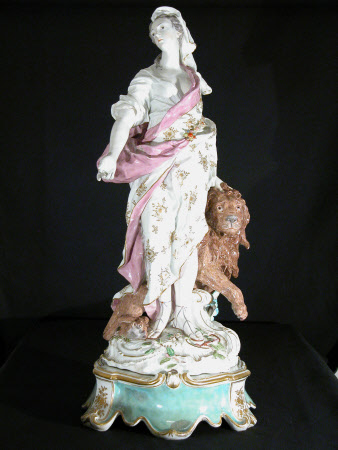Una and the Lion
Chelsea Porcelain Factory (1744-1769)
Category
Ceramics
Date
1756 - 1760
Materials
Soft paste porcelain
Measurements
26.0 in (Height of figure)
Place of origin
Chelsea
Order this imageCollection
Upton House, Warwickshire
NT 446371
Summary
Chelsea group of Una and the Lion, c.1756-60. Soft-paste porcelain painted with enamels and gilt, apparently unmarked. Probably from a model by the Franco-Flemish modeller Joseph Willems who was born in Brussels in 1715 and modelled for the Chelsea factory between 1750-1766. Figure and pedestal separate. Height of figure 26 in. (60 cm.). The pedestal measures 4 5/16 x 12 3/4 x 11 in. (10.9 x 32.4 x 28cm). Acquired in November 1923 by Marcus Samuel, 1st Viscount Bearsted (1853-1927), from the antiques dealer, Albert Amor Ltd.; Amor discovered it in a sale on the premises of 7 Chesterfield Gardens, Mayfair, held on 28 September 1923, by Phillips, Son & Neale (Lot 629), catalogued as Meissen porcelain, when he purchased it for £150. It was included in an auction sale of the collection of Sir Lionel Phillips, 1st Baronet (1855-1936),a South African 'Randlord', held at Christie’s, London, on 23 April 1913, Lot 677, when it was catalogued as 'Britannia with a lion... 27 in., high,... on a pedestal with green panels': it sold to a J. Howard for 125 guineas (£131.50). The figure was published in 1900, when in the collection of Mrs. Phillips, by Frederick Litchfield, 'Pottery and Porcelain: a Guide to Collectors'. In the nineteenth century the figure was often identified as Britannia. The figure of Una may be based on drawings by the Palladian architect William Kent, now in the Victoria and Albert Museum, illustrating Spenser's 'Faerie Queene', published in 1751. Una may have been regarded as a heroine of the Gothick romanticisation of Arthurian Britain. P. Ferguson, 2014
Makers and roles
Chelsea Porcelain Factory (1744-1769), manufacturer
